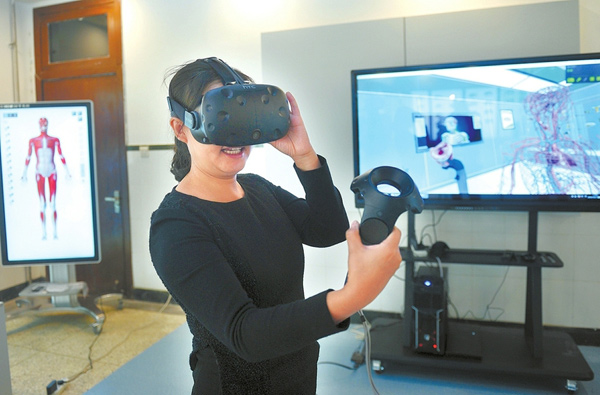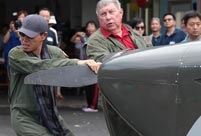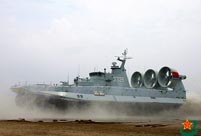


A teacher shows the students how to observe the human body structure at the VR anatomy course. (Photo/West China Metropolis Daily)

The VR image of human body. (Photo/West China Metropolis Daily)
The awards ceremony for the 2016 First Season VRCORE Hardcore VR Developer Tournament was held in Beijing on Oct. 18. The VR version of a 3-D anatomy course developed by Sichuan University won the best application award, and was also nominated for the best trans-boundary award. The technology innovatively displays the human body for medical students.
In the Simulation Anatomy course at West China Foundation Medicine and Forensics School of Sichuan University, a student wearing VR glasses stood in front of the screen as the teacher narrated what the student was seeing. Students in the class could not only observe the organs and structures of the human body through VR technology, they could also could “pick up” an organ and put it near their eyes to observe.
It took five years for the research team to develop this VR anatomy course. Anatomy is an essential course for all medical students. However, the lack of human specimens has caused difficulties in teaching the subject. Ideally, five or six students share one human specimen, but in many medical schools dozens of students are forced to share.
Some schools use atlases and dummies for teaching. However, the three-dimensional interior structures of the human body are hard to convey through two-dimensional illustrations.
Wang Fan, a medical professor from Sichuan University, offered an example. According to Wang, when doing craniocerebral operations, the doctor must know the structure and layout of cerebral vessels. This is hard to describe through words, and hard for students to understand without seeing the actual human brain. VR technology can help students to observe important structures and vessels.
Li Hua, vice dean of the West China Foundation Medicine and Forensics School of Sichuan University, said that the school’s VR anatomy course has successfully digitized the human body. It is a good example of the fruitful intersection of medicine and computer technology.
 Home-made plane completes test flight in Chicago
Home-made plane completes test flight in Chicago The untold stories of women in the Long March
The untold stories of women in the Long March Female soldiers on Frigate Jingzhou
Female soldiers on Frigate Jingzhou Top 10 most beautiful Chinese athletes in Rio
Top 10 most beautiful Chinese athletes in Rio Shenzhen seizes 549 tons of illegally smuggled clothing
Shenzhen seizes 549 tons of illegally smuggled clothing Chinese actor Wang Baoqiang divorces wife, fires manager
Chinese actor Wang Baoqiang divorces wife, fires manager Hangzhou: host city of G20 Summit
Hangzhou: host city of G20 Summit New hovercrafts debut in landing exercise
New hovercrafts debut in landing exercise Woman sets Guinness World Record with 17-month-long pregnancy
Woman sets Guinness World Record with 17-month-long pregnancy Top 10 livable Chinese cities
Top 10 livable Chinese cities Top 20 hottest women in the world in 2014
Top 20 hottest women in the world in 2014 Top 10 hardest languages to learn
Top 10 hardest languages to learn China’s Top 10 Unique Bridges, Highways and Roads
China’s Top 10 Unique Bridges, Highways and Roads Time to let dust settle on South China Sea
Time to let dust settle on South China Sea
 Chinese pubic glued to US election debate for entertainment
Chinese pubic glued to US election debate for entertainment
 Dying 'victim’ tries to clear her teacher’s name in Cultural Revolution rape case
Dying 'victim’ tries to clear her teacher’s name in Cultural Revolution rape case
 Elderly people tricked by scammers who say they are helping fight ‘foreign enemies’
Elderly people tricked by scammers who say they are helping fight ‘foreign enemies’